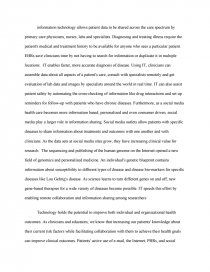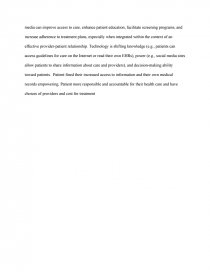Organizational Structure and Culture in Health Care
Essay by Stella • February 6, 2012 • Essay • 419 Words (2 Pages) • 3,146 Views
Essay Preview: Organizational Structure and Culture in Health Care
information technology allows patient data to be shared across the care spectrum by primary care physicians, nurses, labs and specialists. Diagnosing and treating illness require the patient's medical and treatment history to be available for anyone who sees a particular patient. EHRs save clinicians time by not having to search for information or duplicate it in multiple locations. IT enables faster, more accurate diagnosis of disease. Using IT, clinicians can assemble data about all aspects of a patient's care, consult with specialists remotely and get evaluation of lab data and images by specialists around the world in real time. IT can also assist patient safety by automating the cross-checking of information like drug interactions and set up reminders for follow-up with patients who have chronic diseases. Furthermore, as a social media health care becomes more information based, personalized and even consumer driven, social media play a larger role in information sharing. Social media outlets allow patients with specific diseases to share information about treatments and outcomes with one another and with clinicians. As the data sets at social media sites grow, they have increasing clinical value for research. The sequencing and publishing of the human genome on the Internet opened a new field of genomics and personalized medicine. An individual's genetic blueprint contains information about susceptibility to different types of disease and disease bio-markers for specific diseases like Lou Gehrig's disease. As science learns to turn different genes on and off, new gene-based therapies for a wide variety of diseases become possible. IT speeds this effort by enabling remote collaboration and information sharing among researchers
Technology holds the potential to improve both individual and organizational health outcomes. As clinicians and educators, we know that increasing our patients' knowledge about their current risk factors while facilitating collaboration with them to achieve their health goals can improve clinical outcomes. Patients' active use of e-mail, the Internet, PHRs, and social media can improve access to care, enhance patient education, facilitate screening programs, and increase adherence to treatment plans, especially when integrated within the context of an effective provider-patient relationship. Technology is shifting knowledge (e.g., patients can access guidelines for care on the Internet or read their own EHRs), power (e.g., social media sites allow patients to share information about care and providers), and decision-making ability toward patients. Patient fined their increased access to information and their own medical records empowering. Patient more responsible and accountable for their health care and have choices of providers and cost for treatment
...
...

